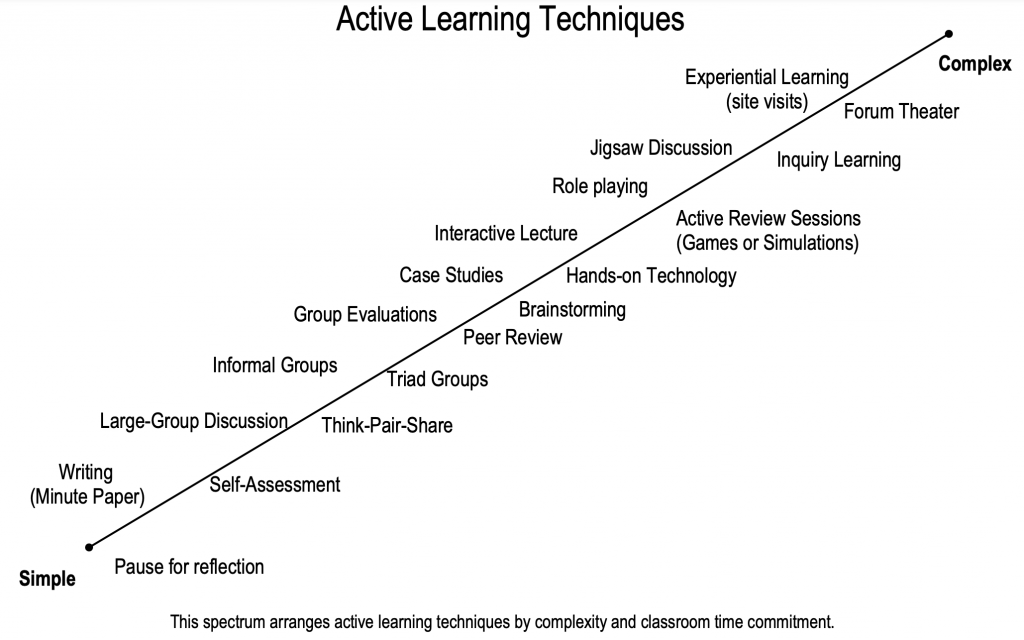Student Engagement Techniques
Student engagement is widely recognized as an important influence on achievement and learning. Berkely (2010) describes student engagement as “the product of motivation and active learning“.
Active Learning
Student engagement is commonly associated with active learning. Active learning is an instructional method that engages studnets in the learning process.
Why does active learning matter? It improves knowledge retention, deepens understanding and encourages self-directed learning.
Lecture based classes are often characterized by instructor’s content delivery. However, instructors can consider different approaches to lecture that introduce more active and participatory components, enhancing higher orders of thinking and learning during class.
Active Learning Techniques

When instructors plan to incorporate active modes of learning into the lecture format, there are four key aspects to consider:
- Define Learning Outcomes: What should students know or be able to do at the end of the lecture? Instructors can review outcomes at the conclusion, ask students to assess their efforts towards the outcomes, and share points that still confusing.
- Assess Prior Knowledge: What is the ability and background of the students? Instructors can access student prior knowledge through clicker questions and other formative assessments, and use this information to modify their lecture as needed.
- Consider the Room: If seats are (or not) fixed to the floor, instructors can consider a variety of seating arrangements that naturally improve quantity and quality of interactions among students and instructor.
- Watch the Time: How much information can be included within the time allotment? Instructors should design lectures that incorporate questions and discussions into a reasonable spread of material and activities.
Adapted from Yale Poorvu Center for Teaching and Learning. Effective Lecturing.
Recommendations
Student engagement strategies for your teaching:
- Active learning: Create a teaching and learning environment primed for student participation.
- Participatory teaching: The focus of participatory teaching is on self-regulation and self-reflection. Specific strategies include using different teaching methods and varying means of assessment.
- Flip the classroom: Flip the traditional lecture-homework relationship.
- Technology in the classroom: Educational technology can be used to provide active learning activities and to keep students engaged outside the classroom.
- Classroom management strategies: Create a set of guidelines.
- Inquiry-based learning: Students are encouraged to explore the material, ask questions and share ideas through small-group discussion and guided learning.
- Cooperative learning: Arrange students in partners or small groups to help them achieve learning goals. Group work can include assignments, discussions, and reviews.
- Authentic learning experiences: Students tackle real-world problems and attempt to come up with a solution through methods such as simulations or case studies.
Student engagement strategies for assessments:
- Prepare for class before class: Exercise such as pre-class quizzes ensure they are knowledgeable enough to contribute.
- Assess early and often: Frequent quizzes for formative assessment work well alongside traditional midterm and final exams.
- Assess attendance: Consider making attendance part of their overall assessment.
- Problem-based/project-based learning: Students are tasked with solving a problem or a completing a case, simulation, or project.
Adapted from Top Hat Blog. 31 Student Engagement Strategies for Any College Course: Use these tactics and activities to ensure your students are engaged and active partners in the learning process.
References
- Chris O’Neal and Tershia Pinder-Grover, Center for Research on Learning and Teaching, University of Michigan.
- Top Hat Staff, Higher Ed Trends, 31 Student Engagement Strategies for Any College Course: Use these tactics and activities to ensure your students are engaged and active partners in the learning process.
